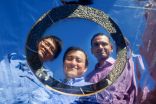(Press-News.org) Johns Hopkins researchers report that their test of an interventional X-ray guidance device approved by the U.S. Food and Drug Administration in 2013 has the potential to reduce the radiation exposure of patients undergoing intra-arterial therapy (IAT) for liver cancer.
In a report prepared for presentation Dec. 3 at the 100th annual meeting of the Radiological Society of North America in Chicago (abstract #SSM24-02), the researchers described the results of a clinical trial of the imaging system AlluraClarity, made by Philips Healthcare, on 50 patients with liver cancer. Its use reduced radiation exposure up to 80 percent, compared with exposure from a standard imaging X-ray platform used in IAT, while producing images just as clear as the standard system, says Jean-Francois Geschwind, M.D., a professor in the Russell H. Morgan Department of Radiology and Radiological Science in the Johns Hopkins University School of Medicine and its Kimmel Cancer Center.
Geschwind says if further studies continue to affirm his team's findings, the platform may be especially useful for patients who need repeat therapy; children, who are especially vulnerable to radiation; and physicians who routinely use procedures such as IAT and are exposed to radiation.
During IAT, a physician inserts a thin, flexible tube directly into a blood vessel feeding a tumor, using that pathway to deliver chemotherapy or other drugs. X-ray imaging is used during the procedure to visualize the patient's blood vessels and to guide both the catheter's placement and drug delivery.
Geschwind and his colleagues compared the radiation exposure of 25 patients with liver cancer treated with IAT using the AlluraClarity platform to the exposure of 25 additional patients with liver cancer treated with IAT using Philips' previous X-ray imaging platform, called Allura.
Lowering the radiation power on standard X-ray imaging platforms can reduce the exposure, but without special image processing, the amount of image noise increases and physicians are unable to see small structures needed for good treatment, says Ruediger Schernthaner, M.D., a postdoctoral research fellow in vascular and interventional radiology at The Johns Hopkins Hospital. "You can compare this to an image taken with your cell phone in the evening without a flash," he says.
The AlluraClarity platform uses a series of real-time image processing algorithms to achieve high quality images at a lower radiation power, Schernthaner says.
INFORMATION:
Other researchers who contributed to the study include MingDe Lin of Philips Healthcare (makers of AlluraClarity) and Julius Chapiro, Rafael Duran, and Boris Gorodetski of The Johns Hopkins Hospital.
The study was funded by the Max Kade Foundation, the National Institutes of Health's National Cancer Institute (R01 CA160771) and Philips Research North America.
Geschwind is a consultant for BTG, Guerbet, Boston Scientific and Bayer Healthcare. He is a paid member of the Philips Radiology Medical Advisory Network. He has received grants from National Institutes of Health, Philips Healthcare (makers of AlluraClarity), the Department of Defense, BTG, Bayer HealthCare, Nordion, Context Vision, the Society of Interventional Radiology, the Radiological Society of North America and Guerbet. He is a founder and CEO of PreScience Labs, LLC.
RSNA Abstract: http://rsna2014.rsna.org/program/details/?emID=14011417
Johns Hopkins Medicine (JHM), headquartered in Baltimore, Maryland, is a $7 billion integrated global health enterprise and one of the leading academic health care systems in the United States. JHM unites physicians and scientists of the Johns Hopkins University School of Medicine with the organizations, health professionals and facilities of The Johns Hopkins Hospital and Health System. JHM's vision, "Together, we will deliver the promise of medicine," is supported by its mission to improve the health of the community and the world by setting the standard of excellence in medical education, research and clinical care. Diverse and inclusive, JHM educates medical students, scientists, health care professionals and the public; conducts biomedical research; and provides patient-centered medicine to prevent, diagnose and treat human illness. JHM operates six academic and community hospitals, four suburban health care and surgery centers, and more than 39 Johns Hopkins Community Physicians sites. The Johns Hopkins Hospital, opened in 1889, has been ranked number one in the nation by U.S. News & World Report for 22 years of the survey's 25 year history, most recently in 2013. For more information about Johns Hopkins Medicine, its research, education and clinical programs, and for the latest health, science and research news, visit http://www.hopkinsmedicine.org.
Plasmid DNA attached to the outer surface of a sounding rocket may be able to withstand rocket launch, a period of residence in suborbital space, re-entry, and landing conditions into the Earth's atmosphere, all the while staying intact and active in its function as carrier of genetic information, according to a study published November 26, 2014 in the open-access journal PLOS ONE by Cora Thiel and Oliver Ullrich from University of Zurich and colleagues.
DNA plays an important role as a biomarker for the search of extraterrestrial signatures of life, and scientists are ...
Potential 'vampires' buried in northwestern Poland with sickles and rocks across their bodies were likely local and not immigrants to the region, according to a study published November 26, 2014 in the open-access journal PLOS ONE by Lesley Gregoricka from University of South Alabama and colleagues.
In northwestern Poland, apotropaic funerary rites--a traditional practice intended to prevent evil--occurred throughout the 17th-18th c. AD. Those of the dead considered at risk for becoming vampires for a variety of reasons were given specific treatment, and investigating ...
Shifts in the timing and duration of ice cover, especially the possible lengthening of ice-free periods, may impact polar bears under projected warming before the end of the 21st century, according to a study published November 26, 2014 in the open-access journal PLOS ONE by Stephen Hamilton from University of Alberta and colleagues.
Sea ice across the Arctic is declining and altering physical characteristics of marine ecosystems, and polar bears are vulnerable to these changes in sea ice conditions. The authors of this study used sea ice projections for the Canadian ...
Induced pluripotent stem cells made from patients with a form of blistering skin disease can be genetically corrected and used to grow back healthy skin cells in laboratory dishes, researchers at the Stanford University School of Medicine have found. They've termed the new technique "therapeutic reprogramming."
The skin cells formed normal human skin when grafted onto the backs of laboratory mice, they said.
The findings represent a major advance in the battle against the disease, epidermolysis bullosa, in which the top layer of skin, called the epidermis, sloughs off ...
Some people say that reading "Harry Potter and the Sorcerer's Stone" taught them the importance of friends, or that easy decisions are seldom right. Carnegie Mellon University scientists used a chapter of that book to learn a different lesson: identifying what different regions of the brain are doing when people read.
Researchers from CMU's Machine Learning Department performed functional magnetic resonance imaging (fMRI) scans of eight people as they read a chapter of that Potter book. They then analyzed the scans, cubic millimeter by cubic millimeter, for every four-word ...
Applied to the outer shell of the payload section of a rocket using pipettes, small, double-stranded DNA molecules flew into space from Earth and back again. After the launch, space flight, re-entry into Earth's atmosphere and landing, the so-called plasmid DNA molecules were still found on all the application points on the rocket from the TEXUS-49 mission. And this was not the only surprise: For the most part, the DNA salvaged was even still able to transfer genetic information to bacterial and connective tissue cells. "This study provides experimental evidence that the ...
Scientists investigating the potentially deadly hantavirus have used a novel approach to developing protective antibodies against it. Their work, published in today's online edition of Science Translational Medicine, provides proof of concept for producing antibodies against a broad range of human pathogens.
Hantaviruses cause a condition known as hantavirus pulmonary syndrome (HPS), which has a case fatality rate of 35-40 percent. Currently there are no licensed vaccines, prophylactics, or therapeutics to prevent or treat this highly pathogenic disease.
This research ...
This news release is available in German.
Scientists led by Kristina Djinović-Carugo at the Max F. Perutz Laboratories (MFPL) of the University of Vienna and the Medical University of Vienna have elucidated the molecular structure and regulation of the essential muscle protein α-actinin. The new findings allow unprecedented insights into the protein's mode of action and its role in muscle disorders. The findings, made in collaboration with King's College London (KCL), may lead to improved treatments, and are published in the top-class journal Cell.
Most ...
A popular indigestion medication can increase survival in colorectal cancer, according to research published in ecancermedicalscience. But in fact, scientists have studied this for years - and a group of cancer advocates want to know why this research isn't more widely used.
"Cimetidine is an interesting drug as it's very safe, very well-known, and has clinical results in cancer that have been confirmed in a number of trials," says Pan Pantziarka, lead author of the paper and member of the Repurposing Drugs in Oncology (ReDO) project.
Cimetidine treats indigestion ...
Stanford engineers have invented a revolutionary coating material that can help cool buildings, even on sunny days, by radiating heat away from the buildings and sending it directly into space.
A team led by electrical engineering Professor Shanhui Fan and research associate Aaswath Raman reported this energy-saving breakthrough in the journal Nature.
The heart of the invention is an ultrathin, multilayered material that deals with light, both invisible and visible, in a new way.
Invisible light in the form of infrared radiation is one of the ways that all objects ...





